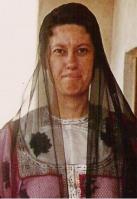Eid Celebrations
 Susan notes: In 1962, nine years before the UAE was born, Canadian nurse the late Gertrude Dyck went to work in Al Ain’s first hospital.
She lived in the UAE and Oman for more than 43 years, and is the author of “The Oasis, Al Ain Memoirs of ‘Doctora Latifa.
This is what she told me about her memories of the Holy Month of
Ramadan in the 1960s. Read more about Gertrude at these links:
About Gertrude Dyck
and
Gertrude Dyck (Nurse/Missionary/Author).
Susan notes: In 1962, nine years before the UAE was born, Canadian nurse the late Gertrude Dyck went to work in Al Ain’s first hospital.
She lived in the UAE and Oman for more than 43 years, and is the author of “The Oasis, Al Ain Memoirs of ‘Doctora Latifa.
This is what she told me about her memories of the Holy Month of
Ramadan in the 1960s. Read more about Gertrude at these links:
About Gertrude Dyck
and
Gertrude Dyck (Nurse/Missionary/Author).
At the end of Ramadan, everyone celebrated Eid Al Fitr.
It was a time of great celebration, spending time with family and friends, and feasting, just as it is now. (Gertrude, at right, in her first Arabic dress and shayla)
I loved the Eid because of all the visiting we did. In the sixties and early seventies, there were only about 2,000 people in the whole Al Ain area, but hundreds would come from all over to visit during the Eid.
The hospital staff, including myself, followed the local customs for visiting and we were quite strict on protocol, which was that you visited the highest of the royalty first.
Royal Visits
We soon learned that the royal women would all meet at Um Eshuukh’s home (Sheikh Zayed's mother) and later at Sheikha Miriam’s, Sheikh Zayed's sister. And if we went there in the afternoon, we would see all of them at one place! But some meant for us to visit in their home as well. That was all a very great honour and privilege for us.The men would go to visit Sheikh Zayed and Sheikh khalifa, and all of the ones they could – there were a lot of places to go!
Sheikh Shakbut was ruler of Abu Dhabi until 1966, and during the early 60s he would invite the whole hospital staff to his home in Al Ain to have a big meal with him, all sitting on the floor. He would arrange the protocol! That was always a highlight of the year for us.
We knew all of the royalty, because they all came to our hospital; the women all came to us for deliveries, so we knew them personally. And not only did they come to the hospital, but we were called to their homes to make pre- and post-natal visits, and also any medical calls for anyone in the family – from grandmother to servant! So during the Eid it was important for us to visit everybody.
In the earliest years, women, such as myself and my colleagues, visited Sheikh Zayed's mother, and his sister, Sheikha Miriam, first. Then we would go to Sheikha Hussa, Sheikh Khalifa's mother, followed by Sheikh Zayed's other wives and then we would visit other members of royalty in whatever order we thought was proper.
Family Trees
I made a whole list of names of who the royalty were, where they lived, and who was related to whom, so that others at the hospital would know where to go if I wasn’t there.As you know, in Islam, men are allowed to have up to four wives at any one time. Sheikh Zayed’s job was to keep the country together and he did that partly through the women he married.
He took wives from various areas and tribes to get allegiance from them, like a kind of a political arrangement, just as the European royalty did to create strategic alliances between countries long ago.
Sheikh Zayed had several wives and about 30 children in those days. He was very good to all of them. We knew the mothers of Sheikh Khalifa, Sheikh Sultan, Sheikh Mohammed, Sheikh Said, Sheikh Saif, and Sheikh Essa, who were all the first sons of their mothers.
I kept a book of the families and all their children’s birthdates. Then, when those children grew up and got married, I recorded the dates of their weddings, whom they married and when they in turn had children. It was wonderful!
Equal Treatment
Other families were usually not as big as Sheikh Zayed’s, because others could not afford it. It was very expensive to have that many weddings, and then to provide for so many families.Of course the husband is expected to treat all the wives equally. If he builds a nice new home for one wife and her children, then he should build one like it for his other wives as well. However, there’s often a certain hierarchy between the wives, the first wife usually, but not always, having more importance than the ones that follow.
No matter how large or small the family, everyone, from the baby up, had to get new clothes for Al Eid - even new underwear! As guests in this country, we were also careful to wear more discreet clothes, and nice new dresses for the Eid.
Everything nowadays is more stylish, with greater quantities of food, and more kinds of food. The clothes are more beautiful and the cars coming and going are more modern - the Rolls Royce will often come out for the Eid, and grandfather's old Cadillac too!
Related links:
Gertrude's story